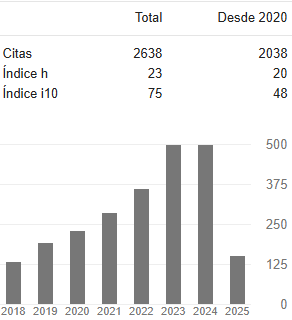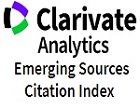Cálculo y análisis de la máxima eficiencia anual de los seguidores solares
DOI:
https://doi.org/10.31908/19098367.3812Palabras clave:
Eficiencia seguidor solar, máxima eficiencia teórica, metodología cálculo, soporte móvilResumen
En este trabajo se propone una metodologíaestándar para el cálculo de la efi ciencia de los seguidores solarespara cualquier latitud geográfi ca. En la revisión bibliográfi cahubo una selección de los artículos afi nes para analizar lainformación, a partir de lo cual se identifi có una dispersiónde los resultados reportados respecto al valor medio. Sedesarrolló un algoritmo para calcular la efi ciencia energéticamáxima teórica, basado en una revisión científi ca del conceptode efi ciencia. El algoritmo se programó y se corrió de acuerdocon la latitud de los reportes, obteniendo valores máximos deefi ciencia teórica para cada una de las latitudes reportadas,con diferencias signifi cativas respecto a los datos presentadospor los autores. En los artículos estudiados no se identifi canmetodologías claras para el cálculo de la efi ciencia de losseguidores solares. La metodología propuesta puede servir dereferencia, ya que la efi ciencia real no puede ser mayor que lateórica.
Descargas
Referencias
Kanyarusoke, K., Gryzagoridis, J. and Oliver, G., “Are solar trackingtechnologies feasible for domestic applications in rural tropicalAfrica?”, J. of Energy in Southern Afric, vol. 26, no. 1, pp. 86–95,2015.
Mehrtash, M. et al., “Performance Evaluation of Sun TrackingPhotovoltaic Systems in Canada”, in 20th Annual Int. Conference onMechanical Engineering ISME2012, School of Mech. Eng., ShirazUniversity, Shiraz, Iran. Performance pp. 18–21, 2012.
Kusekar, S., “Tracking of Solar Panel by Hydraulic System”, Int.J. of Informative & Futuristic Research (IJIFR), vol. 2, no. 8, pp.2856–2881, 2015.
Specifications of solar trackers used for photovoltaic systems, IEC62108 Int. Electrotechnical Commission, pp. 3–26, 2007 [Online].Available:https://www.google.com.co/url?sa=t&rct=j&q=&esrc=s&source=web&cd=1&cad=ja&uact=8&ved=0ahUKEwiWsP_K79PSAhVI9mMKHW3nAgwQFgg5MAA&url=http%3A%-2F%2Fstandardsproposals.bsigroup.com%2Fhome%2Fgetpdf%2F534&usg=AFQjCNGZL0ud2i0rCcUPCf7gGRhqXzENSw&sig2=ZDm9QDIlMlOQqDcpcnpK_Q [Consulted:
-15-2017].
Valcárcel, J. and González, H, “Application of Technological Systems of Solar Energy Conversion”, Entre Ciencia e Ingeniería, Año 5. No. 9, pp. 9 – 17, 2011.
Rumbayan, M. and Dwisnanto, M., “A Concept of Solar Tracker System Design”, Int. J. of Engineering Sciences & Research Technology, vol 6. (11), November 2017, pp. 440-448 DOI: 10.5281/ zenodo.1066204, 2017.
Rizman, Z. et al., “Design a Simple Solar Tracker for Hybrid Power Supply”, J. of Fundamental and Applied Sciences, 10 (2S), pp. 333- 346, February 2018.
Eberechi, R. and Nyebuchi, H., “Design and Implementation of an Off-Grid Solar Tracker Control System using Proteus Version 8.1”, IOSR Journal of Engineering (IOSRJEN), vol. 08, Issue 4, pp. 04- 12, April 2018.
Morón, C. et al., “New Prototype of Photovoltaic Solar Tracker Based on Arduino”, Energies (MDPI), vol. 10, 2017, pp.1-13; doi:10.3390/en10091298, 2017.
Ganesh, J. et al., “Design and Development of a Sun Tracking mechanism using the Direct SMA actuation”, Dept. of Mech. Eng., Texas A&M University, College Station, TX, USA, 2011 [Online]. Avalilable: https://www.researchgate .net/ publication/277371404_ Design_and_Development_of_a_Sun_Tracking_Mechanism_ Using_the_Direct_SMA_Actuation [Consulted: 02-03-2017].
Odeh, S. and Abu-Mulaweh, H., “Design and development of an educational solar tracking parabolic trough collector system”, Global J. of Eng. Educ., vol. 15, no. 1, pp. 21–27, 2013.
Clifford, M. and Eastwood, D., “Design of a novel passive solar tracker”, Solar Energy, vol. 77, pp. 269–280, 2004.
Al-Mohamad, A., “Efficiency improvements of photo-voltaic panels using a Sun-tracking system”, Appl. Energy, vol. 79, pp. 345–354, 2004.
Huang, B. J., Ding, W. L. and Huang, Y. C., “Long-term field test of solar PV power generation using one-axis 3-position sun tracker”. Solar Energy, vol. 85, no. 9, pp. 1935–1944, 2011.
Hsing, A., “Solar Panel Tracker”, Elect. Eng. Dept., California Polytechnic State University San Luis Obispo, 2010. [Online]. Available: http://digitalcommons.calpoly. edu/cgi/ viewcontent .cgi? article=1060&context=eesp [Consulted 01-10-2017].
Absallah, S. and Bradan, O., “Sun tracking system for productivity enhancement of solar still”, Sci. Direct Desalination, vol. 220, pp. 669–676, 2008.
Garg, A. et al., “Solar Tracking: An Efficient Method Of Improving Solar Plant Efficiency”, Int. J. of Elect. and Electron. Engineers, vol. 7, no. 1, pp. 199–203, 2015.
Kivrak, S., Gunduzalp, M. and Dincer, F. “Theoretical and experimental performance investigation of a two- axis solar tracker under the climatic condition of Denizli”, Turkey”, Przegląd Elektrotechniczny (Electrical Review), no. 2, pp. 332–336, 2012.
Tudorache, T., Oancea, C. and Kreindler, L., “Performance Evaluation of a Solar Tracking PV Panel”. U.P.B. Sci. Bull., Series C, vol. 74, pp. 3–10, 2012.
Dhanabal, R. et al., “Comparison of Efficiencies of Solar Tracker systems with static panel Single-Axis Tracking System and DualAxis Tracking System with Fixed Mount”, Int. J. of Eng. and Technology (IJET), vol. 5, no. 2, pp. 1925–1933, 2013.
Ghosh, S. and Roy, S., “Designing a Dual-Axis Solar Tracking System”, Int. J. Adv. Res. Electr. Electron. Instrum. Eng., vol. 5, no. 12, pp. 9039–9043, 2016.
Gupta, P. et al., “Azimuth-Altitude Dual Axis Solar Tracker”, IOSR J. Electr. Electron. Eng., vol. 11, No. 5, pp. 26–30, 2016.
Vij, K. and Kumar, R., “Theoretical Gain in Solar Energy for Different Sun Tracking Systems in Delhi”, Int. Advanced Research J. in Sci., Eng. and Technology, vol. 3, no. 7, pp. 213–218, 2016.
Duffie, J. A. and Beckman, W. A., Solar Engineering of Thermal Processes, 4th ed.; New Jersey: John Wiley & Sons, Inc., pp. 18- 928, 2013.
Chen, J., “Tracking sunlight”, in Physic of Solar Energy; New Jersey: John Wiley & Sons, Inc, ch. 4, pp. 77-104, 2011.
Descargas
Publicado
Número
Sección
Licencia
Derechos de autor 2019 Entre Ciencia e Ingeniería

Esta obra está bajo una licencia internacional Creative Commons Atribución-NoComercial 4.0.



















